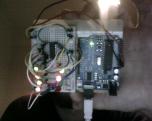 This project refers to an Arduino sketch that implements a light indicator with the help of an external sensor (photoresistor) for the recognition of light, and a bar graph of many LEDs used as a rating indicator. Furthermore, if the indicator reaches the last rating which indicates that there is “perfect” light (the maximum light that the sensor can identify) then it plays a melody with a piezo speaker located in the system.
This project refers to an Arduino sketch that implements a light indicator with the help of an external sensor (photoresistor) for the recognition of light, and a bar graph of many LEDs used as a rating indicator. Furthermore, if the indicator reaches the last rating which indicates that there is “perfect” light (the maximum light that the sensor can identify) then it plays a melody with a piezo speaker located in the system.
Tag Archive: LEDs
Arduino: Light Indicator with multi-LED bar graph and light sensor.
Arduino: Alarm clock with light sensor and ON / OFF buttons.
This project refers to an Arduino sketch that implements a simple alarm clock using a light sensor, a piezo speaker, two buttons for functions such as ON, OFF and an LED as the function indicator. When the alarm is in OFF state, then it carries no real operation (just turns off the function indicator), and when in ON state, then it turns on the function indicator and examines whether there is sufficient ambient light (via the light sensor) to produces a musical tune with piezo speaker. This process is repeated continuously if there is sufficient light until the button OFF is pressed.
Arduino: LEDs animations controlled by a button.
 This project refers to an Arduino sketch which is used to produce animations with more than one LED. You can place several LEDs in a row or in any order you wish and enjoy the flow of traffic. Furthermore, if you wish to change the animation you can choose the next in line by pressing a special button. One such application might remind you of the Christmas lights.
This project refers to an Arduino sketch which is used to produce animations with more than one LED. You can place several LEDs in a row or in any order you wish and enjoy the flow of traffic. Furthermore, if you wish to change the animation you can choose the next in line by pressing a special button. One such application might remind you of the Christmas lights.
The project ‘bgc-leds’ (Handling BGC-8088’s LEDs).
Within the framework of the course “Computer Architecture – Laboratory” (Department of Informatics and Communications, T.E.I. of Central Macedonia), I felt the wish to develop a program that flashes in a sequential manner the light-emitting diodes of the development platform BGC-8088.
Arduino: Adjustable mood lighting with voice recognition.
This project refers to an Arduino sketch which, with the help of an RGB LED and a VRBot system, can implement a mood lighting system controlled by voice commands. There are voice commands to activate / deactivate the red, green and blue. The color changes are performed with fade effects.
Arduino: Remote Morse Code Web Encoder.
This project refers to an Arduino sketch that implements an online Morse Code web encoder. The Morse Code is until now a global communication system. However, it is now rarely used (it has been previously extensively used in the Navy and the Army in general). In this project, the Arduino works as a server, which remote clients can be connected to with the help of TCP sockets and send occasional messages on a regular alphanumeric form.
For example: “SOS! USA NAVY (12/02/1920, 23:00)”
This project refers to an Arduino sketch which implements a POV (Persistence Of Vision) case for the representation of text messages which can contain the visible characters of the character set ASCII.
Arduino: Light Indicator with multi-LED bar graph, light sensor and 8-bit shift register 74HC595.
This project refers to an Arduino sketch that implements a light indicator with the help of an external sensor (photoresistor) for the recognition of light (the sensor acts as input device for the Arduino), and a bar graph of many LEDs used as a rating indicator (the indicator functions as an output device for the Arduino).
In this project we use an 8-bit shift register (namely the 74HC595). This way we can drive 8 different LEDs in the output committing only three PINS of the Arduino.
 This project refers to an Arduino sketch which is used to produce LEDs animations. So, we use an 8-bit shift register (namely the 74HC595). This way we can drive 8 different LEDs in the output committing only three PINS of the Arduino.
This project refers to an Arduino sketch which is used to produce LEDs animations. So, we use an 8-bit shift register (namely the 74HC595). This way we can drive 8 different LEDs in the output committing only three PINS of the Arduino.
If we want to drive more LEDs, we connect into a cascade form two or more (depending on the number of LEDs we want to support) shift registers and act accordingly.
This project refers to an Arduino sketch which with the help of an external potentiometer (input device) can control a bar graph of many LEDs. Finally, when the sketch starts running, it calibrates the potentiometer (and so there should be a spin at both ends manually).
This project refers to an Arduino sketch that implements a simple fire alarm using a temperature sensor, a piezo speaker and one LED as indicator for deaf-mute cases. The alarm checks every second if there is enough room temperature (via the temperature sensor). If there is enough temperature to consider it a fire burning in that place, then the alarm produces a musical tune with the piezo speaker and lights the LED indicator. Otherwise, both the speaker and the LED indicator remain in state OFF.
This project refers to an Arduino sketch which with the help of an external potentiometer (input device) can move the position of a servo motor (output device) clockwise or counterclockwise. The system also features two LEDs which – each time the value of the potentiometer changes – change their brightness in such a way that it is obvious in which side of the servo motor are.
For example, when the potentiometer is in the extreme left position then the left LED is lit 100% while the right one 0% (or vice versa). Finally, when the sketch starts running, it calibrates first the potentiometer.


